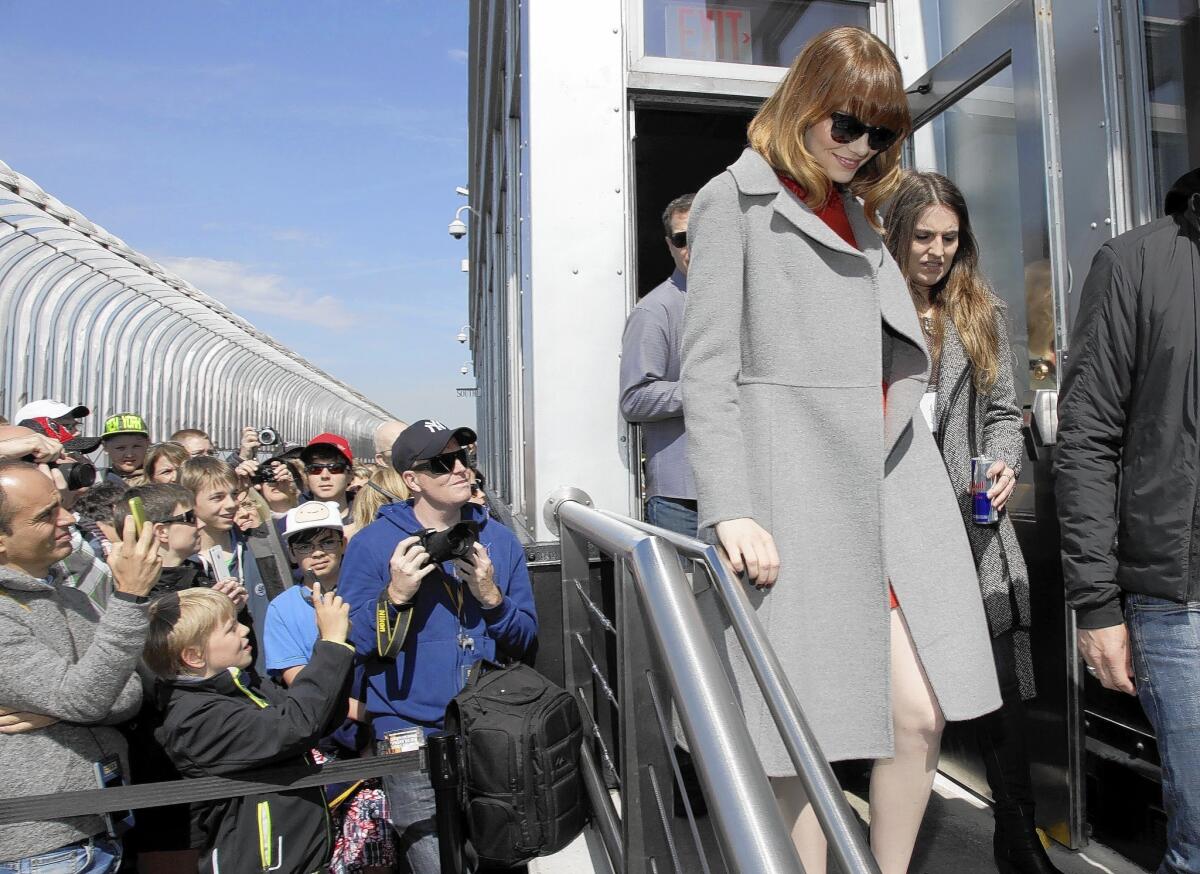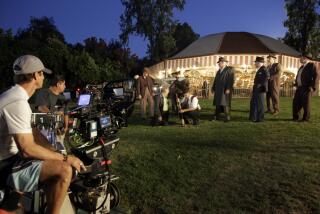New York taking a larger bite out of Hollywood productions

- Share via
Reporting from New York — When director Marc Webb spoke to the big crowd at the premiere of “The Amazing Spider-Man 2” here, he didn’t open by saluting the cast or welcoming the colorfully dressed fans at the Ziegfeld Theatre.
Instead, he gave thanks — to New York.
“We shot this all in New York, which is a great place to shoot a movie,” Webb told onlookers, including delegates from the New York City Mayor’s Office of Media and Entertainment. “I highly recommend it if you get the chance.”
Tinsel Town is being upstaged by the Big Apple — in film location shoots, in TV shows and even in glitzy premieres like the one for “Spider-Man.” The Tom Hanks thriller “Captain Phillips” and “Lee Daniels’ The Butler” also debuted in the city, as did the new season of HBO’s “Game of Thrones.” Leonardo DiCaprio’s “The Great Gatsby” premiered to a black-tie audience at Lincoln Center, followed by a Roaring ‘20s-themed party at The Plaza with giant flaming bottles of Moet.
What’s happening on the red carpet mirrors what’s happening on film sets and TV soundstages. New York had a record number of film and TV projects last year and is on track to do the same in 2014, state officials say. Credit goes to generous financial incentives, experienced crews that rival Hollywood’s best and friendly (some might say star-struck) politicians.
“There was a period of time when we lost our edge,” said Kenneth Adams, chief executive of Empire State Development, the state’s main economic development agency. “We’ve regrouped and come back stronger than ever.”
The shift in television production is especially dramatic, and was underscored by NBC’s decision last year to move the “Tonight Show” to Manhattan after decades in Burbank. That move was part of a larger trend — New York City is now home to 29 TV series, compared with seven a decade ago, according to the Office of Media and Entertainment.
This summer New York City will debut its biggest-ever TV production, a $200-million, 60-episode television series for Netflix based on the Marvel Defenders characters.
By comparison, Los Angeles has seen a sharp decline in its share of TV production, especially for one-hour dramas. During last year’s pilot season, Los Angeles captured only 22% of all TV pilots for dramas, down from 63% in 2007, according to a study by FilmL.A. Inc.
Entertainment industry experts point to New York’s incentives as the biggest reason for the state’s growing film and TV production business.
The state of New York provides up to $420 million annually in rebates to the film industry — four times what California spends. New York’s credit also covers big-budget movies and new network TV dramas that are specifically excluded from California’s program.
“They are building on their innate strengths and really flourishing,” said Assemblyman Mike Gatto (D-Los Angeles), who has co-authored a bill, AB-1839, that would make California’s incentives more attractive. “We have to take some steps to compete.”
Supporters of the bill have cited New York’s success as a reason to bolster California’s film program.
Last week, however, the California Legislative Analyst’s Office said the program’s fiscal benefits had been exaggerated and warned that expanding funding could lead to a “race to the bottom” competition among states for Hollywood’s business.
“If the Legislature wishes to continue to expand the film tax credit, we suggest that it do so cautiously,” the report said. “Responding to other jurisdictions’ subsidies could be very expensive.”
That language could be seen as lending credence to something filmmakers have been saying for a few years now: that New York is a more welcoming environment.
“They’ve made it really attractive, the way L.A. used to be,” said Webb, whose movie was a bonanza for New York with a $200-million-plus production budget that employed 3,900 cast and crew members and 5,223 extras.
Much of the credit for revitalizing New York’s entertainment industry goes to former Mayor Michael Bloomberg and his film commissioner, Katherine Oliver.
To make the city film-friendly, it provided free police assistance to crews and discounts to filmmakers using local vendors, and worked with a Brooklyn nonprofit group to train low-income New Yorkers as production assistants. A marketing credit provides free advertising in subways, buses and Taxi-TV for productions that make a donation to a local cultural institution.
All the activity has resulted in some grumbling from notoriously impatient New Yorkers who are increasingly forced to share streets and sidewalks with film crews. The mayor’s film office has seen its ranks thinned in the past few years as a result of budget cuts, and the city has a new film commissioner since Bloomberg left office.
Even so, indications are that new Mayor Bill de Blasio — who recently appeared on the CBS TV show “The Good Wife” — will keep the film-friendly tradition going.
“This industry is in the DNA of this city,” De Blasio said at a news conference announcing his film chief, Cynthia Lopez. “It’s part of who we are. It’s part of what makes us great.”
The film industry also has friends in Albany, which authorizes the tax credits.
“The Empire State is home to the best talent, crews, locations and other resources needed to support productions and post-production of any and all sizes,” Gov. Andrew Cuomo said in a statement to The Times, “and we will continue to help the hard-working men and women in those jobs achieve the next big hit.”
L.A. Mayor Eric Garcetti, who took office nearly a year ago, says he is committed to fighting back. He created the city’s first film office and recently appointed veteran entertainment attorney Ken Ziffren to be the city’s “film czar.”
“I applaud New York,” Garcetti said. “They’ve had forward-looking policymakers at the state level that have really made a difference. It’s time for California to do the same.... Entertainment is who we are and I intend to compete and win.”
After David Letterman announced last month that he would retire from the “Late Show,” Garcetti reached out to CBS Chief Executive Les Moonves, urging him to move the show west when Stephen Colbert takes over next year. But Moonves also heard from Cuomo and De Blasio, who asked him to keep the show in Manhattan’s historic Ed Sullivan Theater.
No decision has been announced, but few insiders think the “Late Show” is heading west.
Although most production still centers in L.A., its dominance is slipping. New York’s entertainment sector was the fastest growing in the country over the last decade, according to a report by the Milken Institute. Between 2004 and 2012, New York saw its entertainment sector expand by 10,675 jobs — a 25% increase.
During the same period, California lost 16,137 film and TV industry jobs, an 11% decline, the report found.
“If L.A. wants to stay the center for entertainment, we need to look at what New York is doing,” said Kevin Klowden, a managing economist at Milken.
For many years, New York was considered too expensive and logistically difficult to serve as a film location. That’s one reason L.A. has hosted so many quintessentially New York shows, including “Seinfeld” and “NYPD Blue.” On studio backlots in Hollywood, a “New York street” is a common feature.
A pivotal moment for New York came in 2003, when producers of a USA Network movie about former Mayor Rudolph Giuliani decided to use Montreal as a stand-in for Manhattan, thanks to lucrative Canadian filming incentives.
Tired of being played by others, New York decided to fight back. The state initially offered a modest 10% rebate, then expanded to 30% in 2008. The plan allows filmmakers to get back 30 cents for every dollar they spend in the state on qualified production costs, such as salaries for crew and set construction.
New York’s legislature increased funding to the current level in 2010, making it the most generous in the country. Cuomo approved another five-year extension through 2019. The state also lured more high-wage visual-effects work after it expanded its post-production credit to a maximum of 35% for companies in upstate New York.
The incentives helped create a windfall of new production. Last year, the state tax credit program drew a record 181 film and TV projects representing an estimated $2.1 billion in spending, up from just 18 projects and about $600,000 in spending a decade earlier.
These days, the spirit of production hovers over the city. Trailers, catering stations and walkie-talkie-equipped production assistants are a common sight on its streets. Subway ads include the “Made in NY” campaign that promotes local television and film production in the city.
Several new soundstages are sprouting across the state. In Staten Island, plans are underway to convert a former state prison into a 100,000-square-foot production complex in the next two years.
On Long Island, former aerospace hangars have been converted to soundstages housing such projects as “Spider-Man 2” and NBC’s “The Sound of Music Live!”
And at the Brooklyn Naval Yard, Steiner Studios has constructed 10 soundstages in the last decade. The 26-acre complex, which is home to “Boardwalk Empire” and other shows, also recently partnered with the city and Carnegie Mellon University to house a media technology program.
“The volume of business being done in New York is at an all-time peak,” said Doug Steiner, the studios’ chairman.
Times Staff Writer Joe Flint contributed to this report.
Verrier reported from Los Angeles; Zeitchik reported from New York.
More to Read
Sign up for The Envelope
Get exclusive awards season news, in-depth interviews and columnist Glenn Whipp’s must-read analysis straight to your inbox.
You may occasionally receive promotional content from the Los Angeles Times.








